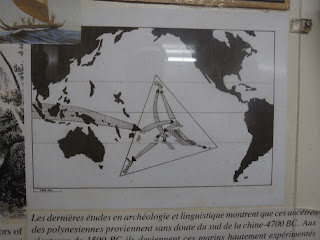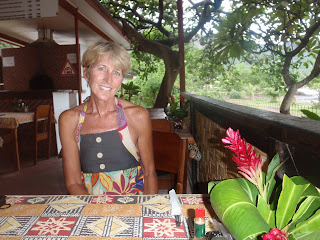 We just arrived at the atoll of Kauehi.
We just arrived at the atoll of Kauehi.
We made 570 miles from the Marquesas in 3 days 22 hours. It was a real nice "wind"ow to take.
The town is small and looks cute. Maybe 30 houses total.
The water is turquoise, the sand is white white, and the sky bright blue. Lots of coral. A nice snorkel reef is 50 yards from our stern.
 We arrived at the pass when the NOAA chart showed low slack tide. Instead, we had 4 kts of current against us. We were doing 1kt at one point. Need to figure out the tides. We could have anchored up close to the beach with 1 ft below the keel but then the tide may still be going out and we would be aground, so we are in 20ft and I still have to dive and check the anchor while Booker looks for sharks.
We arrived at the pass when the NOAA chart showed low slack tide. Instead, we had 4 kts of current against us. We were doing 1kt at one point. Need to figure out the tides. We could have anchored up close to the beach with 1 ft below the keel but then the tide may still be going out and we would be aground, so we are in 20ft and I still have to dive and check the anchor while Booker looks for sharks.The little church really has personality. Everything up in the ceiling made of shells.
We'll stay here for a few days and then it's 30 miles over to Fatuhiva which should be a perfect distance to allow for slack tide at both inlet. If we can ever figure out the tide.
Note: Found it: The only correct source for tides is www.shom.fr
This is Jimmy.
We were walking down the street and this guy driving down the street in a beatup pickup truck loaded with bags of something stops and says, "Welcome to my island". He must be the only guy that speaks English which was nice. As he was driving away he says "That is my house up there, do you want to come see it?" So, we walk 50 yards and he has already sent his cousin out to pull down 2 coconuts for us to drink while we sat at the table and talked.
This is Jimmy's Boathouse.
This is Jimmy's Mom, Josephine. She is stringing little shells together to make a necklace.
IDENT: WDD5204
TIME: 2013/04/28 20:45
LATITUDE: 15-49.00S
LONGITUDE: 145-07.00W
COMMENT: www.sailtortuguita.com - Arrived Kauehi - 570nm in 3 days 22 hrs




















